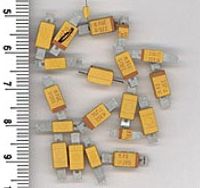The chemical element tantalum is classed as a transition metal. It was discovered in 1802 by Anders G. Ekeberg.

Data Zone
| Classification: | Tantalum is a transition metal |
| Color: | gray |
| Atomic weight: | 180.947 |
| State: | solid |
| Melting point: | 3020 oC, 3293 K |
| Boiling point: | 5560 oC, 5833 K |
| Electrons: | 73 |
| Protons: | 73 |
| Neutrons in most abundant isotope: | 108 |
| Shells: | 2,8,18,32,11,2 |
| Electron configuration: | [Xe] 4f14 5d3 6s2 |
| Density @ 20oC: | 16.6 g/cm3 |
Reactions, Compounds, Radii, Conductivities
| Atomic volume: | 10.90 cm3/mol |
| Structure: | bcc: body-centered cubic |
| Hardness: | 6.5 mohs |
| Specific heat capacity | 0.14 J g-1 K-1 |
| Heat of fusion | 36.57 kJ mol-1 |
| Heat of atomization | 782 kJ mol-1 |
| Heat of vaporization | 737 kJ mol-1 |
| 1st ionization energy | 761 kJ mol-1 |
| 2nd ionization energy | 1500 kJ mol-1 |
| 3rd ionization energy | – |
| Electron affinity | 31.1 kJ mol-1 |
| Minimum oxidation number | -1 |
| Min. common oxidation no. | 0 |
| Maximum oxidation number | 5 |
| Max. common oxidation no. | 5 |
| Electronegativity (Pauling Scale) | 1.5 |
| Polarizability volume | 13.1 Å3 |
| Reaction with air | none |
| Reaction with 15 M HNO3 | none |
| Reaction with 6 M HCl | none |
| Reaction with 6 M NaOH | none |
| Oxide(s) | TaO2, Ta2O5 |
| Hydride(s) | Ta2H |
| Chloride(s) | TaCl3, TaCl4, TaCl5 |
| Atomic radius | 146 pm |
| Ionic radius (1+ ion) | – |
| Ionic radius (2+ ion) | – |
| Ionic radius (3+ ion) | 86 pm |
| Ionic radius (1- ion) | – |
| Ionic radius (2- ion) | – |
| Ionic radius (3- ion) | – |
| Thermal conductivity | 57.5 W m-1 K-1 |
| Electrical conductivity | 8.1 x 106 S m-1 |
| Freezing/Melting point: | 3020 oC, 3293 K |

High purity tantalum. Photo by Tomihahndorf.

Tantalum capacitors
Discovery of Tantalum
Tantalum was discovered by Anders G. Ekeberg in 1802, in Uppsala, Sweden, in the minerals tantalite from Finland and yttrotantalite from Sweden.
Unfortunately for Ekeberg, in 1809 the well-known English chemist Willian Wollaston said there had been no discovery and there was no new element.
Wollaston claimed Ekeberg’s new element was actually niobium, which had also been discovered in 1802. The scientific community came to believe Wollaston was right and that Ekeberg’s claim for a new element had been a mistake.
Tantalum and niobium are in fact hard to separate from one another, which led to Wollaston’s error.
In 1846 German mineralogist Heinrich Rose finally proved beyond doubt that tantalum and niobium were different elements.
In 1903 Werner von Bolton refined tantalum metal for the first time.
The element name comes from the Greek mythological character Tantalos. Niobe (niobium) was the daughter of Tantalos. Ekeberg gave his new element the name tantalum because it had been a tantalizing element to find.
Appearance and Characteristics
Harmful effects:
Tantalum is considered to be non-toxic.
Characteristics:
Tantalum is a rare, shiny, gray, dense metal. It is highly ductile and can be drawn into a thin wire.
Its chemical properties are very similar to those of niobium. Tantalum is highly corrosion resistant due to the formation of an oxide film. It is an excellent conductor of heat and electricity.
The metal has a melting point exceeded only by tungsten and rhenium. Tantalum is one of the five major refractory metals (metals with very high resistance to heat and wear). The other refractory metals are tungsten, molybdenum, rhenium and niobium.
Uses of Tantalum
Tantalum is used in the electronics industry for capacitors and high power resistors.
It is also used to make alloys to increase strength, ductility and corrosion resistance.
The metal is used in dental and surgical instruments and implants, as it causes no immune response.
Abundance and Isotopes
Abundance earth’s crust: 1.7 parts per million by weight, 0.2 parts per million by moles
Abundance solar system:
Cost, pure: $450 per 100g
Cost, bulk: $8.10 per 100g
Source: Tantalum is not found free in nature but in minerals such as columbite and tantalite. Minerals that contain tantalum often also contain niobium. Commercially, tantalum is extracted by first forming the oxide (Ta2O5). The oxide is then reduced using carbon or hydrogen.
Isotopes: Tantalum has 31 isotopes whose half-lives are known, with mass numbers from 156 to 186. Naturally occurring tantalum consists of its one stable isotope, 181Ta.

References
Cite this Page
For online linking, please copy and paste one of the following:
<a href="https://www.chemicool.com/elements/tantalum.html">Tantalum</a>
or
<a href="https://www.chemicool.com/elements/tantalum.html">Tantalum Element Facts</a>
To cite this page in an academic document, please use the following MLA compliant citation:
"Tantalum." Chemicool Periodic Table. Chemicool.com. 18 Oct. 2012. Web. <https://www.chemicool.com/elements/tantalum.html>.
this is a helpful website. im so glad i found this.
This website is great:P It helped me answer alot of questions!